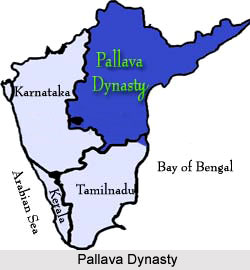 The word Pallava meaning branch or twig in Sanskrit is delivered as Tondaiyar in Tamil language. The Pallava kings at numerous places are termed as Tondamans or Tondaiyarkon. The word Tondan in Tamil means slave, servant, adherent or assistant and can either be suggestive of the subordinate position the Pallavas bore to the Satavahanas or reflect a dominant position pallavas enjoyed at the time of satvahanas. On disintegration of the Satvahana authority, the Pallavas avowed themselves and invaded a large part of Chola province but the soubriquet Tondon stayed and their region also came to be known as Tondamandlam. The word Pallava is a translation of Tamil word Tondaiyar and Tondaman and this discovers corroboration in various copper plate charters that bring in `tender twigs` (pallavams) of some kind in association with the eponymous name Pallava`.
The word Pallava meaning branch or twig in Sanskrit is delivered as Tondaiyar in Tamil language. The Pallava kings at numerous places are termed as Tondamans or Tondaiyarkon. The word Tondan in Tamil means slave, servant, adherent or assistant and can either be suggestive of the subordinate position the Pallavas bore to the Satavahanas or reflect a dominant position pallavas enjoyed at the time of satvahanas. On disintegration of the Satvahana authority, the Pallavas avowed themselves and invaded a large part of Chola province but the soubriquet Tondon stayed and their region also came to be known as Tondamandlam. The word Pallava is a translation of Tamil word Tondaiyar and Tondaman and this discovers corroboration in various copper plate charters that bring in `tender twigs` (pallavams) of some kind in association with the eponymous name Pallava`.
But scholars rebuff this view since it is a later usage of the term and consequently cannot be confirmed to have given rise to the family name Pallava. Some feel that the Pallavas are connected with primordial Pulindas, who were the same as the Kurumbas of Tondamandlam. Tondamandlam was a province under Maurya Emperor Ashoka in third century BCE and was later detained by the Satavahanas and thus Tondamandlam became a feudatory to the Satavahanas After collapse of Satavahanas in about 225 AD, the Pallavas of Tondamandlam became autonomous and prolonged to the Krishna River.
There have been several conjectures concerning the origin of the Pallavas. There are certain claims based on historical, anthropological, and linguistic proof signifying that the Pallavas were related to the Pahlavas of Iran. It is probable that a wave of Pahlava/Kambhoja tribes of Indo-Iranian descent migrated Southward and first settled in Krishna river valley of present day coastal Andhra Pradesh. This province is termed Palnadu or Pallavanadu. Pallavas later unmitigated their swing up to Northern Tamil province and established a prosperous realm.
Some scholars think that the Pahlavas migrated from Persia to India and established the Pallava dynasty of Kanchi, whereas, some say that they were immigrants from north, or from Konkan, Tenugu and Anarta into Deccan. They came into south India through Kuntala or Vanvasa. It is also worth remarking that the close connections of the Sakas (Scythians), the Kambojas and the Pallavas have been highlighted in numerous ancient Sanskrit texts like Mahabharata, Valmiki Ramayana, and the Puranas. In the Puranic literature, the Sakas, Kambojas Yavanas, Pahlavas and Paradas have been distinguished as united tribes, which were situated in the Scythian belt in Central Asia and were hence followers of common culture and social customs. There are other opinions supporting their indigenous origins state that they were hereditary feudatory rulers under the Vakatakas.



















